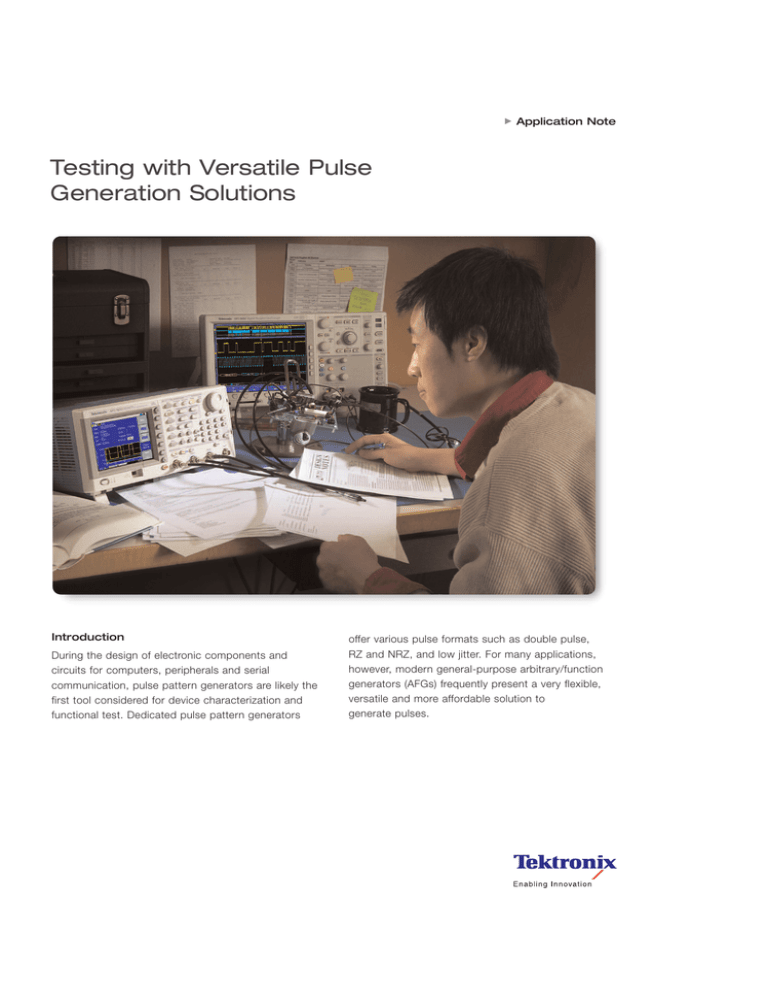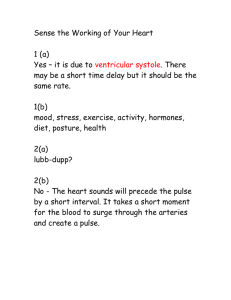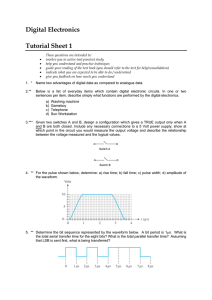
Application Note
Testing with Versatile Pulse
Generation Solutions
Introduction
During the design of electronic components and
circuits for computers, peripherals and serial
communication, pulse pattern generators are likely the
first tool considered for device characterization and
functional test. Dedicated pulse pattern generators
offer various pulse formats such as double pulse,
RZ and NRZ, and low jitter. For many applications,
however, modern general-purpose arbitrary/function
generators (AFGs) frequently present a very flexible,
versatile and more affordable solution to
generate pulses.
Testing with Versatile Pulse Generation Solutions
Application Note
Specification
AFG3251/52
Number of Channels
Pulse Frequency
Variable Leading Edge Time
Variable Trailing Edge Time
Pulse Width
Pulse Period
1/2
1 mHz to 120 MHz
2.5 ns to 625 s
2.5 ns to 625 s
4.00 ns to 999.99 s
8.33 ns to 1000 s
Pulse Duty
0.001% to 99.999%
Lead Delay
0 ps to Period – [Pulse width +
0.8 * (Leading Endge Time +
Trailing Edge Time)]
Overshoot (typical)
Figure 1. Pulse waveform screen of the AFG3252.
< 5%
Amplitude, 50 Ω Load
50 mVp-p to 5 Vp-p
Amplitude, Open Circuit
100 mVp-p to 10 Vp-p
Jitter (RMS, typical)
100 ps
Internal Frequency Reference
±1 ppm
Table 1. Pulse specifications of the AFG3251/52.
AFGs are perfectly suited to generate logic, trigger,
and clock signals, via clock multiplier even supporting
high-speed serial standards such as PCIe and SATA.
This application note explores typical pulse generator
test scenarios using AFGs:
– Measuring Propagation Delay and Signal
Transition Time
– Characterizing Setup and Hold Time
– Evaluating Slew Rate Performance of
Operational Amplifiers
– Generating Pulses with Noise or Jitter for
Stress Testing
– Generating Pulses with Complex Shapes
– Simulating Low Speed Serial Signals
These application examples are based on the AFG3251
and AFG3252 models of the AFG3000 Series. These
models support single and dual channel pulse
generation capability up to 120 MHz, independently
adjustable rise and fall times as short as 2.5 ns,
built-in noise and jitter sources, and the capability
to generate pulses with complex shapes and low
speed serial patterns.
Benefits of Using Arbitrary/Function
Generators for Pulse Generation
Activating the pulse generator function of the AFG3000
Series is as simple as pressing the Pulse button on the
front panel. This brings all relevant waveform
parameters, and a graphical depiction of the pulse
waveform on screen to confirm the active settings.
Table 1 summarizes the pulse related capabilities of the
AFG3251/52.
2
www.tektronix.com/signal_generators
Testing with Versatile Pulse Generation Solutions
Application Note
All pulse related settings (see Figure 2) are quickly
accessible via dedicated shortcut keys on the front
panel, and are adjustable on the fly via rotary knob or
numeric key pad. During timing parameter adjustments,
the output signal remains free from glitches or dropouts,
which is important, for example, when characterizing
devices over a sweeping clock frequency.
Dual channel models are available to support
applications that require more than one input signal.
Since the AFG3000 Series is based on Direct Digital
Synthesis (DDS), signal shape and frequency can be
selected completely independently in both channels.
The signals can also be locked together in frequency
and/or amplitude. In this case, an adjustable phase
delay between both channels can be introduced, which
is extremely useful for measuring channel to channel
timing differences in semiconductor devices.
For stress testing of devices, noise can be added to
pulse signals and jitter to square waves without the
need for a separate function generator, as is the case
for dedicated pulse pattern generators.
Figure 2. Adjustable pulse parameters on the AFG3000 Series.
Engineers who work on a variety of designs benefit from
the versatility of AFGs. Aside from pulse and square
waves, the AFG3000 Series also excels at generating
sine, ramp, and arbitrary waveforms, as well as seven
other standard functions.
One point to consider when comparing AFGs with
dedicated pulse pattern generators is that relative jitter
increases with frequency due to the DDS architecture.
For the AFG3251 and AFG3252, the pulse jitter
specification of 100 ps implies a relative jitter of 0.01%
at 1 MHz, but 1% at 100 MHz.
www.tektronix.com/signal_generators
3
Testing with Versatile Pulse Generation Solutions
Application Note
Figure 4. Oscilloscope screen of propagation delay measurement.
Figure 3. Measurement setup for propagation delay measurement.
Parameters
Measuring Propagation Delay and Signal
Transition Time
In logic devices such as buffers and comparators, a
parameter of interest is the propagation delay or
response time, i.e. the time it takes for the device
output to respond to an input signal. To measure this
parameter, use an AFG3251 or AFG3252 to stimulate
the device input with a pulse signal, and measure device
input and the output signal with an oscilloscope.
Program the signal source to generate pulses of a
frequency and amplitude within the operating range of
the device. As an example, the following provides
instrument settings and measurement results for the
comparator model LM393.
4
www.tektronix.com/signal_generators
Run Mode
Function
Frequency
Leading/Trailing Edge
Setting
Continuous
Pulse
500 kHz
2.5 ns
Amplitude High
5V
Amplitude Low
0V
Table 2. AFG3251/52 settings for comparator characterization.
The yellow trace in Figure 4 depicts the input signal to
the device and the blue trace the output signal. The
oscilloscope measured a response time of 188.7 ns, a
signal output rise time of 121.4 ns and a fall time of
49.3 ns.
Testing with Versatile Pulse Generation Solutions
Application Note
Figure 5. Measurement setup for flip-flop characterization.
Figure 6. AFG3000 screen – Waveform View.
Characterizing Setup and Hold Time
Parameters
In logic circuit timing, setup time and hold time
conditions play a critical role. A logic circuit captures
data at the leading edge of the clock. For the data to
be captured correctly, it needs to settle a certain time
before the clock edge and remain stable for a certain
time after this edge. The necessary settling time before
the clock edge is known as setup time and the
necessary time after the clock edge is known as
hold time.
Run Mode
These values are specified in the datasheet of the
logic IC. They vary with the voltage of the power supply
and other conditions. Necessary tools to measure
setup and hold times are a dual-channel AFG and
an oscilloscope.
Setting
Continuous
Channel 1 - Function
Pulse
Channel 1 - Frequency
5 MHz
Channel 2 - Frequency
10 MHz
Channel 1/2 - Amplitude High
3.3 V
Channel 1/2 - Amplitude Low
0V
Table 3. AFG3252 Settings for flip flop characterization.
To stimulate the device, program the AFG3252 with the
settings in Table 3. Channel 1 generates the clock and
channel 2 the data. To synchronize data and clock
timing, press the Phase/Delay button and then Align
Phase in the soft menu on the screen. The clock,
www.tektronix.com/signal_generators
5
Testing with Versatile Pulse Generation Solutions
Application Note
Figure 7. Sufficient setup time.
data and device output signals are measured with
an oscilloscope.
To determine setup and hold time, press the Delay
button on the AFG3252 front panel and vary the delay
of channel 1 with the rotary knob while observing the
flip flop output signal on the oscilloscope. The delay can
be adjusted in increments as small as 10 ps via the
rotary knob.
Figure 8. Insufficient setup time.
Figure 7 shows input and output signals of the flip flop
for a sufficient setup time. The yellow trace represents
the clock input, the blue trace the data input and the
magenta trace the data output. For the selected setup
time of 10 ns the data input is captured at the clock’s
rising edge and output properly.
Figure 8 shows the flip flop signals for a setup time of 5
ns which is insufficient. The data output fluctuates here
between high and low level, because the data input is
changing its level, while the flip-flop circuit is still
processing the data. The output develops a metastable
state (neither high level nor low level).
Evaluating Slew Rate Performance of
Operational Amplifiers
High-speed operational amplifiers (op amps) are among
the most common analog components in use today.
They can be found in television sets, set-top boxes,
video broadcast equipment, wireless communications
base stations, fiber-optic products, radar systems,
satellite receivers, card readers, bar code scanners,
and many other areas.
6
www.tektronix.com/signal_generators
Testing with Versatile Pulse Generation Solutions
Application Note
Figure 9. Measurement setup for op amp slew rate characterization.
Parameters
Run Mode
Figure 10. At an input signal rise time of 32 ns the op amp output
signal starts to oscillate.
Setting
Continuous
Function
Pulse
Frequency
1 MHz
Amplitude
5 Vp-p
Table 4. AFG3251/52 settings for op amp characterization.
A critical performance aspect of op amps is their
transient response or slew rate performance. Op amps
used in set-top boxes and security video applications
need a high slew rate combined with ultra-low
distortion. Slew rate and transient response are also an
issue for op amps that drive extremely fine movement in
ink jet printers and medical devices.
The op amp’s transient response may be different
for the rising and falling edges of the input signal, a
behavior known as asymmetrical slew rate performance.
It may affect whether the op amp is used in an inverting
or non-inverting configuration. Knowing the timing
characteristics of an op-amp makes it possible to
optimize gain and feedback resistors, or take other
measures to achieve the desired circuit behavior.
To characterize an op amp’s slew rate performance,
Figure 11. Increasing the fall time. The trailing edge of the output
begins to oscillate at some point.
measure its transient response with an oscilloscope
while stimulating its input with a pulse signal with
variable rise time, fall time, and amplitude. The pulse
generation solution used must provide independent
control over these parameters. The Tektronix AFG3000
Series delivers this flexibility, along with ample
bandwidth and precision to ensure accurate results.
www.tektronix.com/signal_generators
7
Testing with Versatile Pulse Generation Solutions
Application Note
Figure 12. Pulse with controlled jitter (upper trace) and without jitter
(lower trace).
Figure 9 shows the measurement setup. The example
discussed here is using a 220 MHz high-speed op amp
intended for video line driver applications.
After entering the basic waveform settings into the
signal source according to Table 4, hold the trailing
(falling) edge constant at 2.5 ns, and increase the
leading (rising) edge gradually from the minimum setting
of 2.5 ns while observing the op amp output signal on
the oscilloscope. In the example here, the output signal
starts to oscillate when the rise time reaches 32 ns
(Figure 10).
Next, keep the leading edge time constant at 32 ns and
slowly increase the trailing edge time starting from 2.5
ns. As Figure 11 reveals, the op amp output starts to
oscillate at a falling edge time of approximately 20 ns.
Clearly this op amp has asymmetrical characteristics.
Figure 13. Pulse with added noise (upper trace) and without added
noise (lower trace).
Parameters
Setting
Run Mode
Modulation
Function
Square
Modulation Type
PM Frequency
Modulation Shape
Deviation
PM
2 mHz to 50.00 kHz
Selectable
0.0° to 180.0°
Table 5. AFG3251/52 settings for jitter generation.
Generating Pulses with Jitter or Noise for
Stress Testing
To assure reliable operation, digital components and
circuits need to be robust against a certain amount of
jitter and noise in clock and data signals. Otherwise,
communication errors or system failures could result.
To evaluate components and circuits for their jitter and
noise tolerance, electronic design engineers need a
solution that can generate pulses with controllable jitter
and noise.
While dedicated pulse pattern generators typically
8
www.tektronix.com/signal_generators
Testing with Versatile Pulse Generation Solutions
Application Note
with 50% duty cycle and well-defined jitter.
Figure 14. Equation Editor in waveform editing software ArbExpress
for creating complex pulses and other waveforms.
require a separate function generator to add signal
distortion, the AFG3000 Series provides a one box
solution with jitter and noise generator built into
the instrument.
Jitter can be added via the built in phase modulator
with selectable modulation frequency, wave shape, and
phase deviation. After you program the instrument with
the settings in Table 5, the instrument will output a pulse
www.tektronix.com/signal_generators
9
Testing with Versatile Pulse Generation Solutions
Application Note
Figure 15. Measurement setup for I2C controlled LED-driver.
Figure 16. ArbExpress marker pane with I2C clock and data signal.
To add noise to any generated signal, simply select the
Output Menu after you press the desired waveform
button and turn on Noise Add. The noise level can then
be selected from 0% to 50%. Please note that Noise
Add reduces the signal amplitude by half to prevent
the noise from clipping at amplitude settings close to
the maximum.
10 www.tektronix.com/signal_generators
Generating Pulses with Complex Shapes
Some applications, as diverse as radar test, magnetic
storage device test and laser spot welding, require
electrical pulses with complex shapes. Aside from
rectangular pulses, the AFG3000 Series provides the
following standard pulse shapes: Sin(x)/x, Gaussian,
Lorentzian, Exponential Rise and Fall. In cases, where
other pulse shapes are needed, you can use the
arbitrary waveform function of the AFG3000 Series and
program the desired pulse shape via mathematical
equations or freehand drawing in the waveform editing
Testing with Versatile Pulse Generation Solutions
Application Note
software, ArbExpress.
Parameters
Creating pulse waves via arbitrary waveform functions
works well with DDS-based arbitrary/function generators
as long as the selected pulse repetition rates are well
below the instrument's clock rate. With a clock rate of
2 GS/s and 500 ps jitter (rms), the AFG3252 supports
a wide range of applications. However, at higher pulse
repetition rates, the waveform point skipping and
duplication inherent to DDS-based generators can lead
to extra jitter.
Run Mode
Simulating Low Speed I2C Serial Signals
Micro-controllers and computers in embedded systems
often utilize low-speed serial buses such as I2C, SPI,
RS-232, CAN and LIN to communicate with specialized
devices such as sensors, switches, a/d-converters,
digital potentiometers and displays. To validate and
stress test new designs, engineers may need to simulate
data and clock signals. The following application
illustrates how I2C bus signals that control a driver for a
numerical LED can be easily created and generated with
a dual-channel arbitrary/function generator.
As the block diagram in Figure 15 shows, channel 1 of
the AFG3252 generates the clock and channel 2 the
Setting
Continuous
Function Channel 1/2
Arb
Frequency CH1=CH2
On
Frequency
1 kHz
Amplitude – Level CH1=CH2
On
Amplitude – High Level
2V
Amplitude – Low Level
0V
Channel 1 – Arb – Arb Waveform Menu
User 1
Channel 2 – Arb – Arb Waveform Menu
User 2
Output Channel 1/2
On
Table 6. AFG3252 settings for I2C signal generation.
data signal.
Data and clock signals are created via the marker
functions of the software package ArbExpress. After
launching the application, select Standard Waveform in
the File menu, select DC as function in the Standard
Waveform window that opens and set the wavelength
to the desired number of points. In the new Wavebook
window that opens, enter the clock and data waveforms
in the marker pane via the right-click mouse functions.
After clock and data signal are created, save the
waveform file in .csv format. Then open this .csv file
www.tektronix.com/signal_generators
11
Contact Tektronix:
ASEAN / Australasia (65) 6356 3900
Austria +41 52 675 3777
Balkan, Israel, South Africa and other ISE Countries +41 52 675 3777
Belgium 07 81 60166
Brazil & South America (11) 40669400
Canada 1 (800) 661-5625
Central East Europe, Ukraine and the Baltics +41 52 675 3777
Central Europe & Greece +41 52 675 3777
Denmark +45 80 88 1401
Finland +41 52 675 3777
France +33 (0) 1 69 86 81 81
Germany +49 (221) 94 77 400
Hong Kong (852) 2585-6688
India (91) 80-22275577
Italy +39 (02) 25086 1
Japan 81 (3) 6714-3010
Luxembourg +44 (0) 1344 392400
Mexico, Central America & Caribbean 52 (55) 5424700
Middle East, Asia and North Africa +41 52 675 3777
The Netherlands 090 02 021797
Norway 800 16098
People’s Republic of China 86 (10) 6235 1230
Poland +41 52 675 3777
Portugal 80 08 12370
Republic of Korea 82 (2) 6917-5000
Russia & CIS +7 (495) 7484900
South Africa +27 11 206 8360
Spain (+34) 901 988 054
Sweden 020 08 80371
Switzerland +41 52 675 3777
Taiwan 886 (2) 2722-9622
United Kingdom & Eire +44 (0) 1344 392400
USA 1 (800) 426-2200
For other areas contact Tektronix, Inc. at: 1 (503) 627-7111
Updated 1 June 2007
Our most up-to-date product information is available at: www.tektronix.com
Copyright © 2007, Tektronix. All rights reserved. Tektronix products are covered by U.S. and foreign
patents, issued and pending. Information in this publication supersedes that in all previously
published material. Specification and price change privileges reserved. TEKTRONIX and TEK are
registered trademarks of Tektronix, Inc. All other trade names referenced are the service marks,
trademarks or registered trademarks of their respective companies.
7/07 FLG/WOW
75W-21097-0




